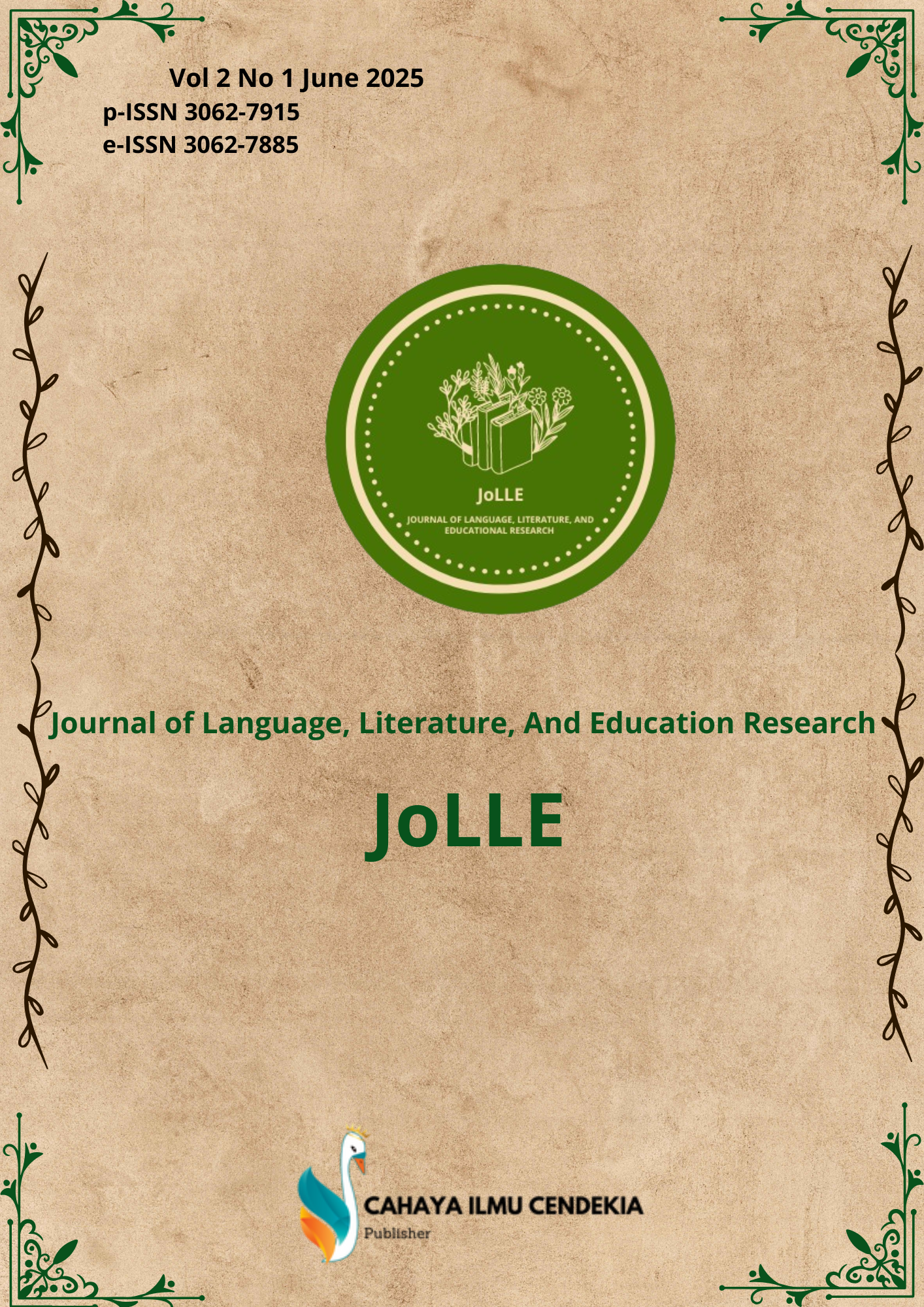Exploring Linguistic Elements In Students’ Written Discussion Texts
Abstract
Purpose of the study: This study aims to examine the language features used by students in writing discussion texts, specifically identifying the frequency and type of features such as modal verbs, conjunctions, and conditional clauses.
Methodology: This qualitative descriptive study used documentation as the data collection technique. The research analyzed 28 discussion texts written by third-semester students in the Genre-Based Writing course at the English Education Department, UIN Walisongo. Analysis was conducted using Feez’s (1998) framework and the categorization of connectors by Celce-Murcia and Larsen-Freeman (1999).
Main Findings: The study revealed that students frequently used modal verbs, particularly “can” and “will,” to express hedging and certainty. Causal connectors like “because” were used more than sequential ones, reflecting the argumentative nature of the texts. However, conditional clauses were underutilized or often misapplied. The texts exhibited general awareness of discussion text features but lacked full mastery in applying them correctly, especially in balancing argumentation and reasoning.
Novelty/Originality of this study: This study contributes to genre-based writing pedagogy by specifically mapping the linguistic elements used in students’ discussion texts. Unlike prior research that mainly addressed discourse markers or argument structure, this study focuses on the integration of specific language features, offering insight into students’ actual grammatical competence within the context of academic genres.
References
M. Alangari, S. Jaworska, and J. Laws, “Who’s afraid of phrasal verbs? The use of phrasal verbs in expert academic writing in the discipline of linguistics,” J. English Acad. Purp., vol. 43, p. 100814, 2020, doi: 10.1016/j.jeap.2019.100814.
P. E. Jones and C. Read, “Mythbusters united? A dialogue over Harris’s integrationist linguistics and Gibson’s Ecological Psychology,” Lang. Sci., vol. 97, p. 101536, 2023, doi: 10.1016/j.langsci.2023.101536.
T. T. Voorhees and O. Vorobel, “Integrating qualitative research into the community college linguistics course: An autoethnographic inquiry,” Int. J. Educ. Res. Open, vol. 2, no. June, p. 100053, 2021, doi: 10.1016/j.ijedro.2021.100053.
E. Leivada and E. Murphy, “Mind the (terminological) gap: 10 misused, ambiguous, or polysemous terms in linguistics,” Ampersand, vol. 8, p. 100073, 2021, doi: 10.1016/j.amper.2021.100073.
K. U. Isisag, “The efficacy of macro-linguistics in developing reading skills: An integrated lesson plan,” Procedia - Soc. Behav. Sci., vol. 9, pp. 698–703, 2010, doi: 10.1016/j.sbspro.2010.12.220.
C. G. Quan, “Continuing with the promise of ‘Scratch’ in the applied linguistics classroom,” Procedia - Soc. Behav. Sci., vol. 103, pp. 245–254, 2013, doi: 10.1016/j.sbspro.2013.10.332.
M. A. Candel-Mora and C. Vargas-Sierra, “An analysis of research production in corpus linguistics applied to translation,” Procedia - Soc. Behav. Sci., vol. 95, pp. 317–324, 2013, doi: 10.1016/j.sbspro.2013.10.653.
R. Z. Abid and S. A. Manan, Integrating corpus linguistics in critical literacy pedagogy: A case study of lance armstrong’s transformation from a titleholder to a fraud, vol. 208, no. Icllic 2014. Elsevier B.V., 2015. doi: 10.1016/j.sbspro.2015.11.189.
H. Jalali, “Reflection of stance through it bundles in applied linguistics,” Ampersand, vol. 4, pp. 30–39, 2017, doi: 10.1016/j.amper.2017.06.001.
M. Pikhart, “New horizons of intercultural communication: Applied linguistics approach,” Procedia - Soc. Behav. Sci., vol. 152, pp. 954–957, 2014, doi: 10.1016/j.sbspro.2014.09.349.
H. Bromhead, “Disaster linguistics, climate change semantics and public discourse studies: a semantically-enhanced discourse study of 2011 Queensland Floods,” Lang. Sci., vol. 85, p. 101381, 2021, doi: 10.1016/j.langsci.2021.101381.
A. M. Fazilatfar and Z. S. Naseri, “Rhetorical moves in applied linguistics articles and their corresponding iranian writer identity,” Procedia - Soc. Behav. Sci., vol. 98, pp. 489–498, 2014, doi: 10.1016/j.sbspro.2014.03.444.
K. Belousov, E. Erofeeva, T. Erofeeva, Y. Leshchenko, and N. Zelyanskaya, “University teachers of linguistics and self-image of their profession,” Procedia - Soc. Behav. Sci., vol. 214, no. June, pp. 667–676, 2015, doi: 10.1016/j.sbspro.2015.11.667.
T. Popescu, “Developing english linguistics students’ translation competence through the language learning process,” Procedia - Soc. Behav. Sci., vol. 93, pp. 1075–1079, 2013, doi: 10.1016/j.sbspro.2013.09.333.
Z. E. Attia, A. M. Gadallah, and H. M. Hefny, “An enhanced multi-view fuzzy information retrieval model based on linguistics,” IERI Procedia, vol. 7, pp. 90–95, 2014, doi: 10.1016/j.ieri.2014.08.015.
Z. Seifoori and J. Fattahi, “The comparison of the method section of applied linguistics articles written by native and iranian writers in terms of grammatical complexity and clause types,” Procedia - Soc. Behav. Sci., vol. 98, pp. 1698–1705, 2014, doi: 10.1016/j.sbspro.2014.03.596.
J. M.-H. Lim, J. M. Storey, S.-L. Chang, M. S. Esa, and S. A. Damit, “Preface: Multiple roles of language and linguistics in society,” Procedia - Soc. Behav. Sci., vol. 134, no. Iclalis 2013, pp. 1–2, 2014, doi: 10.1016/j.sbspro.2014.04.217.
L. Wang, “Designing and implementing outcome-based learning in a linguistics course: A case study in Hong Kong,” Procedia - Soc. Behav. Sci., vol. 12, pp. 9–18, 2011, doi: 10.1016/j.sbspro.2011.02.004.
A. V. Tsepilova and L. V. Mikhaleva, “Working with formulaic language as a way to evaluate and improve EFL non-linguistics students’ pragmatic skills in a culture-specific contextual situation,” Procedia - Soc. Behav. Sci., vol. 200, no. October, pp. 550–556, 2015, doi: 10.1016/j.sbspro.2015.08.022.
Y. Wang and J. Soler, “Investigating predatory publishing in political science: a corpus linguistics approach,” Appl. Corpus Linguist., vol. 1, no. 1, p. 100001, 2021, doi: 10.1016/j.acorp.2021.100001.
S. Pesina and T. Solonchak, “Concept in cognitive linguistics and biocognitive science,” Procedia - Soc. Behav. Sci., vol. 192, no. 3519, pp. 587–592, 2015, doi: 10.1016/j.sbspro.2015.06.100.
A. L. R. Schuster, N. L. Crossnohere, N. B. Campoamor, I. L. Hollin, and J. F. P. Bridges, “The rise of best-worst scaling for prioritization: A transdisciplinary literature review,” J. Choice Model., vol. 50, no. May 2023, p. 100466, 2024, doi: 10.1016/j.jocm.2023.100466.
T. A. Shiryaeva, A. A. Arakelova, E. V. Tikhonova, and N. M. Mekeko, “Anti-, Non-, and Dis-: the linguistics of negative meanings about youtube,” Heliyon, vol. 6, no. 12, 2020, doi: 10.1016/j.heliyon.2020.e05763.
N. V. Semenova and A. N. Sitsyna-Kudryavtseva, “About the term ‘dependent taxis’ in modern linguistics,” Procedia - Soc. Behav. Sci., vol. 200, no. October, pp. 149–156, 2015, doi: 10.1016/j.sbspro.2015.08.036.
M. Brooke, “‘Feminist’ in the sociology of sport: An analysis using legitimation code theory and corpus linguistics,” Ampersand, vol. 7, p. 100068, 2020, doi: 10.1016/j.amper.2020.100068.
H. Van Pham, P. Moore, and B. Cong Cuong, “Applied picture fuzzy sets with knowledge reasoning and linguistics in clinical decision support system,” Neurosci. Informatics, vol. 2, no. 4, p. 100109, 2022, doi: 10.1016/j.neuri.2022.100109.
S. Rezaei, D. Kuhi, and M. Saeidi, “Diachronic corpus analysis of stance markers in research articles: The field of applied linguistics,” Cogent Arts Humanit., vol. 8, no. 1, 2021, doi: 10.1080/23311983.2021.1872165.
D. Khairiah, S. Fatinah, J. Endardi, Nursyamsi, and D. Atmawati, “Genetic relationship between Kaili and Pamona languages: a historical comparative linguistics study,” Cogent Arts Humanit., vol. 11, no. 1, p., 2024, doi: 10.1080/23311983.2024.2409517.
M. Diko, “Harmonizing Africa’s linguistic symphony: navigating the complexities of translating African literature using a postcolonial theory,” Cogent Arts Humanit., vol. 11, no. 1, p., 2024, doi: 10.1080/23311983.2024.2411871.
R. Nhongo and L. Siziba, “Intellectualising African languages in literature and linguistics at selected Zimbabwean higher learning institutions,” South African J. African Lang., vol. 44, no. 3, pp. 223–230, 2024, doi: 10.1080/02572117.2024.2385262.
R. Iye, I. W. Simpen, I. N. Sedeng, I. M. Netra, I. M. Said, and F. I. N. Abida, “Language contextualization in public space in Maluku Province: A landscape linguistics study,” Cogent Arts Humanit., vol. 10, no. 1, 2023, doi: 10.1080/23311983.2023.2247648.
I. Mukahal and M. M. Idrus, “Negation forms in the poetry of philip larkin,” Comp. Lit. East West, vol. 8, no. 2, pp. 207–220, 2024, doi: 10.1080/25723618.2024.2395216.
L. Fontaine, “On prepositions and particles: A case for lexical representation in systemic functional linguistics,” Word, vol. 63, no. 2, pp. 115–135, 2017, doi: 10.1080/00437956.2017.1309029.
Hendrokumoro, F. Darman, N. Nuraeni, and N. K. Ma’shumah, “The genetic relationship between alune, lisabata, luhu, and wemale (western seram, Indonesia): A historical-comparative linguistics approach,” Cogent Arts Humanit., vol. 11, no. 1, p., 2024, doi: 10.1080/23311983.2024.2306718.
D. A. S. El-Dakhs, L. Mardini, and L. Alhabbad, “The persuasive strategies in more and less prestigious linguistics journals: focus on research article abstracts,” Cogent Arts Humanit., vol. 11, no. 1, p., 2024, doi: 10.1080/23311983.2024.2325760.
L. Zhao and P. Issra, “Traditional Chinese Medicine (TCM) research articles unpacked: a systemic functional linguistics (SFL) elemental genre approach,” Cogent Arts Humanit., vol. 11, no. 1, p., 2024, doi: 10.1080/23311983.2024.2317617.
C. Yue, “We make viewpoints in different ways: the use of stance adverbials across academic levels and disciplines,” Cogent Arts Humanit., vol. 11, no. 1, p., 2024, doi: 10.1080/23311983.2024.2435169.
M. P. Di Buono, H. Gonçalo Oliveira, V. Barbu Mititelu, B. Spahiu, and G. Nolano, “Paving the way for enriched metadata of linguistic linked data,” Semant. Web, vol. 13, no. 6, pp. 1133–1157, 2022, doi: 10.3233/SW-222994.
D. Gromann et al., “Multilinguality and LLOD: A survey across linguistic description levels,” Semant. Web, vol. 1, no. 1, pp. 1915–1958, 2024, doi: 10.3233/SW-243591.
A. F. Khan et al., “When linguistics meets web technologies. Recent advances in modelling linguistic linked data,” Semant. Web, vol. 13, no. 6, pp. 987–1050, 2022, doi: 10.3233/SW-222859.
R. Kopečková, U. Gut, M. Wrembel, and A. Balas, “Phonological cross-linguistic influence at the initial stages of L3 acquisition,” Second Lang. Res., vol. 39, no. 4, pp. 1107–1131, 2023, doi: 10.1177/02676583221123994.
R. Alshalan and H. S. Alyousef, “Enhancing English–Arabic translator education through systemic functional linguistics: a study in a Saudi undergraduate classroom,” Saudi J. Lang. Stud., 2025, doi: 10.1108/sjls-09-2024-0054.
A. Q. Al Darwesh, “The representation of authorial and external voice in popular science book writing: a systemic functional linguistics approach,” Saudi J. Lang. Stud., vol. 5, no. 2, pp. 108–127, 2025, doi: 10.1108/sjls-08-2024-0043.
A. Sendra, E. Late, and S. Kumpulainen, “From data lifecycle to research activity model: research data management in data-intensive social sciences and humanities research,” Aslib J. Inf. Manag., 2025, doi: 10.1108/AJIM-12-2024-0959.
O. A. J. Mascarenhas, M. Thakur, and P. Kumar, “On assumptions, presumptions, suppositions, and presuppositions,” A Prim. Crit. Think. Bus. Ethics, pp. 223–253, 2024, doi: 10.1108/978-1-83753-346-620241008.
L. Capoani, M. Fantinelli, and L. Giordano, “The concept of resilience in economics: a comprehensive analysis and systematic review of economic literature,” Contin. Resil. Rev., 2025, doi: 10.1108/crr-11-2024-0045.
K. Berglund, M. Bertilsson, U. Hermansson, M. Sager, E. Wikstrom, and G. Hensing, “Determinants of alcohol preventive actions by managers: a cross-sectional study among Swedish managers,” Int. J. Work. Heal. Manag., no. 220180, 2025, doi: 10.1108/IJWHM-12-2024-0258.
K. M. Al-Balushi, “Teaching english as discourse in Sultan Qaboos University,” Learn. Teach. High. Educ. Gulf Perspect., vol. 7, no. 1, pp. 30–41, 2010, doi: 10.18538/lthe.v7.n1.18.
A. H. Al-Hoorie and A. A. K. AlAwdah, “Transdisciplinary integration for applied linguistics: the case of electrophysiology,” Saudi J. Lang. Stud., vol. 4, no. 2, pp. 97–105, 2024, doi: 10.1108/sjls-06-2024-0028.
A. A. Zughaibi, “The barefoot shoemaker’s son: examining EFL teachers’ pragmatic competence in a Saudi context,” Saudi J. Lang. Stud., vol. 2, no. 2, pp. 68–83, 2022, doi: 10.1108/sjls-02-2022-0013.
Copyright (c) 2025 Siti Fhadillah

This work is licensed under a Creative Commons Attribution 4.0 International License.
Authors who publish with this journal agree to the following terms:
- Authors retain copyright and acknowledge that the Journal of Language, Literature, and Educational Research is the first publisher licensed under a Creative Commons Attribution 4.0 International License.
- Authors are able to enter into separate, additional contractual arrangements for the non-exclusive distribution of the journal's published version of the work (e.g., post it to an institutional repository or publish it in a book), with an acknowledgment of its initial publication in this journal.
- Authors are permitted and encouraged to post their work online (e.g., in institutional repositories or on their website) prior to and during the submission process, as it can lead to productive exchanges and earlier and greater citation of published work.


1.png)

.png)
.png)







